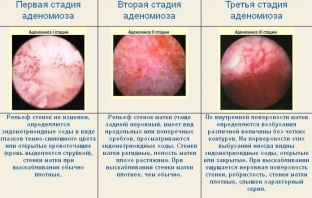The treatment of adenomyosis is not an easy task. On the one hand, this disease requires the maximum application of medical efforts to improve the quality of life of the patient, who suffers greatly from constant severe pain during prolonged menstruation. At the same time, she, as a rule, has problems with her health due to the development of iron deficiency anemia due to heavy menstrual bleeding. On the other hand, adenomyosis refers to recurrent diseases, and therefore requires scrupulous adherence to the treatment regimen and constant monitoring of the patient.
Features and forms of the disease affecting the treatment of adenomyosis
Treatment of adenomyosis is carried out with the choice of individual tactics for each patient, since the reasons that caused the development of adenomyosis should be taken into account (both hereditary factors and the presence of internal diseases, age, hormonal levels). In addition to the causes that caused adenomyosis, it is necessary to determine its form and degree, and on the basis of all the data collected, choose a treatment strategy.
Depending on the depth of damage to the muscular layer of the uterus by sprouted endometrium, four degrees of development of adenomyosis are distinguished. If at the level of the first degree, as a rule, only the submucosal layer of the uterus suffers, then at the second and third degrees, the penetration of the endometrium is already carried out almost to the depth of the middle layer of the uterus, and the fourth degree is characterized by a through lesion of the entire muscular layer of the uterus and even the possible spread of the process to neighboring organs .
As for the forms of adenomyosis, they are differentiated on the basis of the morphological picture of the process and divided as follows:
- focal - separate lesions of adjacent tissue;
- nodular - myoma-like nodes in the myometrium;
- diffuse - lesions in the myometrium do not have clear boundaries;
- mixed - lesions of the myometrium are distinguished both in the form of nodes and in the form of diffuse inflammatory processes.
The treatment of adenomyosis is developed taking into account the form and degree of development of the process, as well as possible concomitant diseases. This takes into account the age of the patient and her desire to have children in the future.

Treatment of adenomyosis in focal and nodular forms of the disease
Usually, the treatment of adenomyosis is conservative or surgical, often these methods are combined. With a focal form of adenomyosis, drug therapy in the form of hormonal and anti-inflammatory drugs, immunomodulators is often sufficient. In parallel, drugs are recommended to increase the level of hemoglobin and, if necessary, drugs for the treatment of neurosis.
If conservative treatment is ineffective or the patient has dense multiple nodules in the myometrium containing blood-filled cavities, a combination of drug therapy with endocoagulation is possible. Endocoagulation is certainly indicated in the presence of adhesions, endometrial hyperplasia, and also if the patient has contraindications to hormone therapy.
Treatment of adenomyosis in diffuse and mixed forms of the disease
The progression of the process, when diffuse and focal lesions of the myometrium causes purulent inflammation with penetrating lesions of the uterus, is combined with myoma, has the risk of developing into a malignant neoplasm, the patient is recommended panhysterectomy.
If a woman is planning a pregnancy and refuses a radical operation, then endocoagulation of the foci is performed, and attempts at conception are allowed no earlier than six months after the end of adenomyosis treatment. Since this is a hormone-dependent disease, the process may subside during the period of bearing a child, but after the birth of the baby, you need to be very careful not to miss the development of a relapse in the patient.
Treatment of adenomyosis is very complex and problematic because this disease has a very high rate of recurrence (except in cases of panhysterectomy). Only in patients in the perimenopausal period, the prognosis is favorable, since ovarian function begins to fade. In other cases, patients need strict medical supervision.






Add a comment